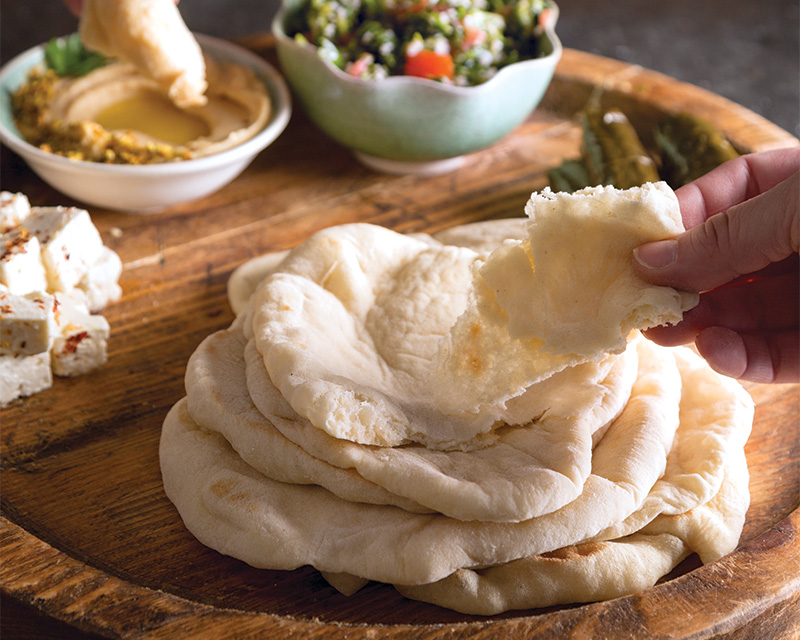
Five Flatbreads to Know:
These flatbreads originate from the Eastern Mediterranean, reaching into the Middle East, and the recipes come from restaurants across America. Bake them, scoop with them, and sponge with them at will.

- Khobz
Origin: Egypt| Pronounce: Khobz with kh sound made in the back of the throat
“If California was an island in the eastern Mediterranean, what would it be like?” That’s Azhar Hashem’s vision for her restaurant, Tawla, where she is joined by Chef Joseph Magidow, formerly of Delfina. Tawla’s menu focuses on the home cooking of Greece, Turkey, the Levant (Syria, Lebanon, Palestine, Israel, Cyprus, Egypt, and Jordan), and Iran. Nowhere is Azhar’s intention more felt than in the simplest of dishes on Tawla’s menu: the bread. “Khobz means ‘bread,’ and references the thin pita that people are used to here,” she says. “Ours is a little thicker, like a hybrid between a traditional Egyptian khobz, which is a Levantine-style dough coated with wheat bran, and a Parisian baguette, which has more weight to it.” This makes it crunchy on the outside, fluffy on the inside, and ripe for spreading with yogurt or muhammara, a Syrian red pepper and walnut spread, which they do liberally at Tawla. In Egypt, you might buy khobz twice a day—“you never sit on old bread”—and, similarly, Azhar bakes hers to order.

2. Nan-e Barbari
Origin: Iran| Pronounce: Noon-ee-bar-bar-ee
In Persian, nan-e barbari translates to “bread of the Barbars,” a group of people who traditionally lived near Iran’s eastern borders. Two things distinguish their flatbread, which has become ubiquitous all over the country. First, its oblong shape. (Hot Bread Kitchen makes one long loaf, but unless you have a really big oven, you’ll likely need to make two oblongs, as directed in this recipe.) Secondly, there’s the roomal, a paste made with flour and water that’s spread onto the surface of each loaf before baking. Roomal ensures that the finished product will be tawny and toothsome. “That layer of moisture creates a bread with a great crust without having to introduce steam into the oven,” says Allegra Ben-Amotz of New York’s Hot Bread Kitchen. And then there are those onion nigella seeds that fleck the surface. “It’s delicious served with feta cheese and olives,” she says.

3. Laffa
Origin: Israel| Pronounce: La-fa
Laffa is an Israeli flatbread, also known as Iraqi pita, that’s cooked in a taboon, a tandoor-like, high-heat clay oven. “There’s lots of crossover from Indian food to Israeli food,” says Michael Solomonov of Zahav in Philadelphia. That’s reflected not only in the naan-like flatbread and the oven in which it’s made, but also by the existence of amba, a tangy mango pickle condiment, in both countries. “And from what I hear, laffa made its way here with the settlement of Iraqi Jews in the 50s,” he says. The dough, which Michael calls “user-friendly” because it’s deliciously fluffy but doesn’t rely on slow fermentation, should be rolled bigger than a typical pita. “Once you set it down, everyone rips it apart and goes to town.” For those of us who don’t have taboons in our home kitchens, a pizza stone or even a baking sheet turned upside down and preheated in the oven will produce beautiful, chewy laffa. “Temperature is really the biggest thing, whether people say it or not,” Michael says. So get it hot!

4. Gözleme
Origin: Turkey| Pronounce: Guz-leh-meh
Gözleme is made from a non-yeasted dough called yufka, which is pliable and easy to work into a thin round. Once that’s been done, usually from a seat on the ground if you’re in a market in Turkey, the dough hits a convex hot plate set in front of its architect, who then sprinkles some fresh spinach and cheese onto its belly. At Middle Eastern-inspired bakery Sofra in Cambridge, Massachusetts, co-owners Ana Sortun and Maura Kilpatrick serve multiple versions of gözleme, one with seasonal farm vegetables, sometimes one with red lentils or sausage, and always one with that traditional spinach-cheese mixture. “In Turkey, they make gözleme to order; they fold it up and put it in paper,” Maura says. “They are daily breads, for sure.”

5. Man’oushé
Origin: Lebanon| Pronounce: Man-oo-shay
There is one bread responsible for Sofra’s existence, and it’s called manoushe (or sometimes man’aeesh). “At every bazaar and every market in Lebanon, there is someone making man’oushé,” says Sofra Pastry Chef Maura Kilpatrick. “And we have a lot of Middle Eastern markets right by the bakery in Watertown; they all do man’oushé, also called za’atar bread because the exterior is bathed in olive oil mixed with za’atar.” Za’atar is a spice mixture made from sesame seeds, thyme, dried sumac, and salt. Maura’s favorite way to eat the yeasted flatbread is to fill it with pickles and herbs, fold it over itself like a taco, and chomp through the alternating spicy and tart layers while walking down the street. “This is the everyday bread of many Eastern Mediterranean countries, but in Lebanon, the dough is stretched out by hand, cooked on a domed griddle, and treated as street food.” She’ll take it—maybe with a little labneh, too.[/vc_column_text][/vc_column][/vc_row]



